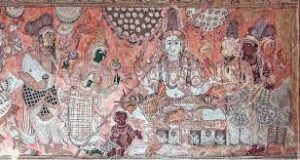India, a land of diverse cultures and rich heritage, is adorned with traditional mural art that reflects the country’s historical, religious, and artistic traditions. These murals, often found in ancient temples, palaces, and caves, serve as visual narratives that depict stories from mythology, daily life, and spirituality. This document aims to shed light on some of the prominent Indian traditional mural sites, showcasing the vibrant and timeless artistry that has been preserved through the ages.
Ajanta Caves, Maharashtra:
-
- Dating back to the 2nd century BCE, the Ajanta Caves are a UNESCO World Heritage site known for their exquisite Buddhist murals.
- The paintings depict the life of Buddha, Jataka tales, and scenes from ancient Indian court life.
- Ajanta murals are characterized by vivid colors, delicate detailing, and a sense of spiritual serenity.
Ellora Caves, Maharashtra:

-
-
- Adjacent to Ajanta, the Ellora Caves house Hindu, Jain, and Buddhist rock-cut temples with stunning murals.
- Cave 16 (Kailasa Temple) features intricate panels illustrating scenes from Hindu epics like the Mahabharata and the Ramayana.
-
- The murals at Ellora showcase the synthesis of various artistic styles over centuries.

Sittanavasal, Tamil Nadu:
-
- Sittanavasal is famous for its rock-cut Jain cave temple adorned with vibrant frescoes datin back to the 9th century.
- The murals depict scenes from Jain mythology and showcase a blend of classical and folk art styles.
- Sittanavasal stands as a testament to the artistic brilliance of ancient Tamil civilization.
Mattancherry Palace, Kerala:

-
-
-
-
- Also known as the Dutch Palace, this 16th-century palace in Kochi features exquisite murals depicting Hindu temple art.
- The murals illustrate episodes from the Ramayana and Mahabharata, as well as portraits of the Rajas of Kochi.
- Mattancherry Palace showcases the unique blend of Kerala mural art with Dutch architecture.
-
-
-
Ranakpur Jain Temple, Rajasthan:

-
- The Ranakpur Jain Temple, dedicated to Tirthankara Adinatha, boasts intricate marble carvings and murals.
- The murals depict scenes from the lives of Jain Tirthankaras, showcasing a high level of detail and precision.
- Ranakpur is a testament to the grandeur of Jain temple artistry in Rajasthan.
Lepakshi, Andhra Pradesh:

-
-
-
-
-
-
- The Veerabhadra Temple at Lepakshi is renowned for its stunning murals narrating episodes from the epics and Puranas.
- The frescoes at Lepakshi showcase the Vijayanagar style of art, with intricate detailing and vibrant color palettes.
- Lepakshi is a treasure trove of art and history, providing a glimpse into the Vijayanagar Empire’s cultural legacy.
-
-
-
-
-
Conclusion:
Indian traditional mural sites offer a captivating journey through time, allowing visitors to witness the evolution of artistic expression in the country. These sites not only preserve the stories of ancient civilizations but also serve as a source of inspiration for contemporary artists and enthusiasts. As custodians of India’s cultural legacy, these mural sites continue to captivate and educate, connecting us to the rich tapestry of India’s artistic heritage.
